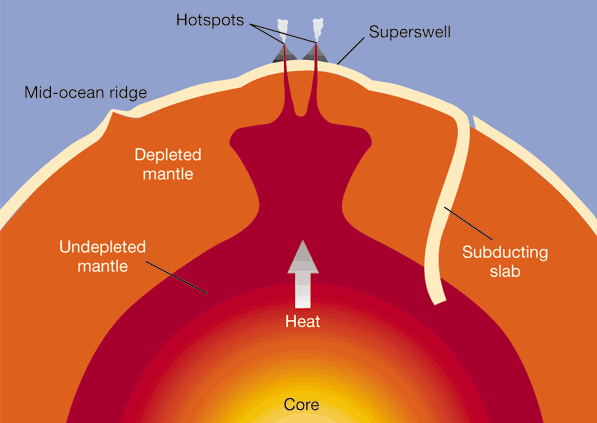Earth’s interior hotter than previously believed

By crushing minerals between diamonds, a University of Utah study suggests the existence of an unknown layer inside Earth: part of the lower mantle where the rock gets three times stiffer. The discovery may explain a mystery: why slabs of Earth’s sinking tectonic plates sometimes stall and thicken 930 miles underground. The findings — published today in the journal Nature Geoscience — also may explain some deep earthquakes, hint that Earth’s interior is hotter than believed, and suggest why partly molten rock or magmas feeding mid-ocean-ridge volcanoes such as Iceland’s differ chemically from magmas supplying island volcanoes like Hawaii’s. “The Earth has many layers, like an onion,” says Lowell Miyagi, an assistant professor of geology and geophysics at the University of Utah. “Most layers are defined by the minerals that are present. Essentially, we have discovered a new layer in the Earth. This layer isn’t defined by the minerals present, but by the strength of these minerals.” Earth’s main layers are the thin crust 4 to 50 miles deep (thinner under oceans, thicker under continents), a mantle extending 1,800 miles deep and the iron core. But there are subdivisions. The crust and some of the upper mantle form 60- to 90-mile-thick tectonic or lithospheric plates that are like the top side of conveyor belts carrying continents and seafloors.
Oceanic plates collide head-on with continental plates offshore from Chile, Peru, Mexico, the Pacific Northwest, Alaska, Kamchatka, Japan and Indonesia. In those places, the leading edge of the oceanic plate bends into a slab that dives or “subducts” under the continent, triggering earthquakes and volcanism as the slabs descend into the mantle, which is like the bottom part of the conveyor belt. The subduction process is slow, with a slab averaging roughly 300 million years to descend, Miyagi estimates. Miyagi and fellow mineral physicist Hauke Marquardt, of Germany’s University of Bayreuth, identified the likely presence of a superviscous layer in the lower mantle by squeezing the mineral ferropericlase between gem-quality diamond anvils in presses. They squeezed it to pressures like those in Earth’s lower mantle. Bridgmanite and ferropericlase are the dominant minerals in the lower mantle. The researchers found that ferropericlase’s strength starts to increase at pressures equivalent to those 410 miles deep — the upper-lower mantle boundary — and the strength increases threefold by the time it peaks at pressure equal to a 930-mile depth.
And when they simulated how ferropericlase behaves mixed with bridgmanite deep underground in the upper part of the lower mantle, they calculated that the viscosity or stiffness of the mantle rock at a depth of 930 miles is some 300 times greater than at the 410-mile-deep upper-lower mantle boundary. “The result was exciting,” Miyagi says. “This viscosity increase is likely to cause subducting slabs to get stuck — at least temporarily — at about 930 miles underground. In fact, previous seismic images show that many slabs appear to ‘pool’ around 930 miles, including under Indonesia and South America’s Pacific coast. This observation has puzzled seismologists for quite some time, but in the last year, there is new consensus from seismologists that most slabs pool.” How stiff or viscous is the viscous layer of the lower mantle? On the pascal-second scale, the viscosity of water is 0.001, peanut butter is 200 and the stiff mantle layer is 1,000 billion billion (or 10 to the 21st power), Miyagi says.
Slab subduction triggers earthquakes and volcanoes
For the new study, Miyagi’s funding came from the U.S. National Science Foundation and Marquardt’s from the German Science Foundation. “Plate motions at the surface cause earthquakes and volcanic eruptions,” Miyagi says. “The reason plates move on the surface is that slabs are heavy, and they pull the plates along as they subduct into Earth’s interior. So anything that affects the way a slab subducts is, up the line, going to affect earthquakes and volcanism.” He says the stalling and buckling of sinking slabs at due to a stiff layer in the mantle may explain some deep earthquakes higher up in the mantle; most quakes are much shallower and in the crust. “Anything that would cause resistance to a slab could potentially cause it to buckle or break higher in the slab, causing a deep earthquake.” Miyagi says the stiff upper part of the lower mantle also may explain different magmas seen at two different kinds of seafloor volcanoes.
Recycled crust and mantle from old slabs eventually emerges as new seafloor during eruptions of volcanic vents along midocean ridges — the rising end of the conveyor belt. The magma in this new plate material has the chemical signature of more recent, shallower, well-mixed magma that had been subducted and erupted through the conveyor belt several times. But in island volcanoes like Hawaii, created by a deep hotspot of partly molten rock, the magma is older, from deeper sources and less well-mixed. Miyagi says the viscous layer in the lower mantle may be what separates the sources of the two different magmas that supply the two different kinds of volcanoes. EP
